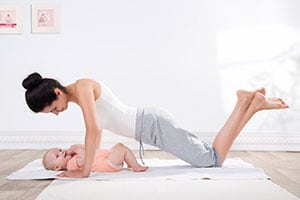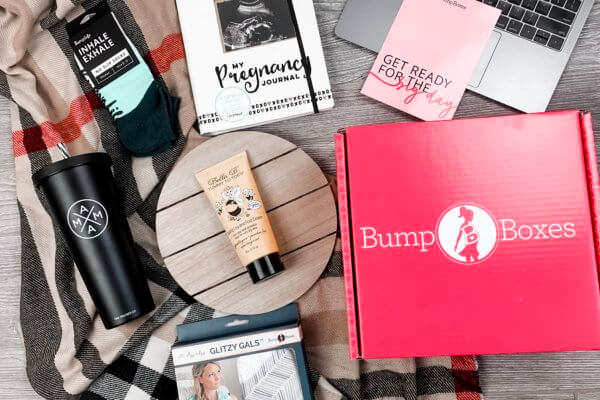In the first year after you give birth, you don’t ever seem to have enough time, hands or help — let alone energy to suit up for a workout. That said, most moms do want to get back in shape and tone up after baby. So, what’s a woman to do? With a spattering of go-to moves, you can squeeze in easy, efficient exercise everyday, almost anywhere. Whether you’ve got baby on board, a 30-minute block, or a few spare minutes, there’s a technique for you.
We asked Joan Pagano, certified personal trainer and author of Strength Training Exercises for Women, and Jimmy Minardi, personal trainer and founder of Minardi Training, to give us a cheat sheet for new moms.
Easy, Everyday Ways to Get Your Body Back After Baby
Practice yoga
Minardi is a big proponent of yoga for full-body strengthening and relaxation — which is exactly what a new mom needs. And there’s no need to leave the house and hit a studio. “There are an abundance of Yoga YouTube sites that have a great home practice that are about 30 minutes long,” he says. “It’s a great way to get in tune with your body and keep the body moving.” Or you can try Yoga International’s 30-Day Free Trial as well as find your premier activewear at theYoga Club.
 Take a nap (with extra benefits)
Take a nap (with extra benefits)
While it might be tempting to squeeze a workout in while the baby naps, you’re better off getting some shut-eye, says Pagano, who insists you should “avoid exercising to fatigue.” But while you’re in bed, she recommends 20 Kegels and 20 belly breaths, “where you pull abdominal muscles toward the spine as you exhale.” Do twice a day to recondition the pelvic floor and core muscles. Then, snooze.
Lunge down a hallway
Some of the best exercises are the simplest, says Minardi, like lunges to work your quads and glutes — no equipment required. “Find a long hallway or room, keep your knees aligned, front knee over your shoe and back knee pointing down,” he says. “Step forward and lunge into a deep squat; the deeper the squat the more effective the exercise.” Alternate legs as you walk down the hallway, and use light weights to work your arms.
Climb some stairs
Minardi says stairs are “a great way to fully engage your muscles, strengthen your glutes and get your heart rate up,” and almost everyone has a set at home. “Whether it’s 3 or 15, you can reap the benefits of a steep incline.”
 Or climb the mountain
Or climb the mountain
There are a few simple exercises that pack the benefits of an “intense, full body workout” into one move. Mountain-climbers fit the bill, says Minardi. “Start in a plank position with your hands slightly wider than shoulder width, and on a subtle incline,” he explains. “Position one leg forward bent under the body and extend the other leg back. Alternate leg positions by pushing hips up while immediately extending your forward leg back and pulling the rear leg forward under the chest line. Land on both forefeet simultaneously.” Repeat, repeat for as many sets of 15 as you can.
Do some jumping jacks
You know that old warm-up routine from your high-school gym class? Well, jumping jacks are actually the forgotten “full-body workout, combining cardio and agility, and targeting every muscle group,” says Minardi, who prescribes 60 at a time. (Who knew?) Do traditional jumping jacks for your first 30, and then try split jacks for your next 30. “Stand in a staggered stance with your right foot in front of your left,” Minardi says. “Simultaneously jump back with right foot and forward with your left as you swing your right arm forward and above your shoulder and swing your left arm back.” Continue, quickly switching legs back and forth as you raise and lower your arms.
Two short walks, twice a day
Instead of walking or jogging on your own, try to walk with your baby so you can sleep when you have the chance. “The best thing a new mom can invest in is a good jogging stroller to do as many outdoor walks as possible,” says Minardi. “Getting outside in the fresh air has amazing health and mood enhancing benefits that will benefit you as a new, sleep-deprived mother. Study after study has shown that outdoor exercise provides greater feelings of revitalization, increased energy and positive engagement, while decreasing tension and depression.” (Look for an indoor space like a mall or track for the indoor months.)

Do a few special push-ups
There are a few exercises you can do while holding your baby, according to Pagano. She calls this one the “kiss the baby” push-up. “Kneel on all fours with the baby on the floor below your chest,” she says. “Keeping your hips over your knees, bend your elbows, lowering your chest toward the floor and kiss the baby. Exhale and straighten your arms to return to start.”
Make “squat-lifts” fun with your baby
Your little one will giggle, and you’ll get a workout with Pagano’s squat-lifts. “Hold the baby in front of your chest and bend your knees, reaching back with the hips into a squat position,” she says. “Straighten your legs and then give the baby a lift by straightening your arms above your shoulders on a diagonal — this strengthens the chest, shoulders and triceps.” Hug the baby into your chest, and repeat the squat-lift 10 to 15 times. Cute facial expressions to entertain are also required.
 Play on the floor using the “bridge-crunch”
Play on the floor using the “bridge-crunch”
For this exercise, you’ll want to lie flat on your back, with knees bent and feet flat on the floor. Hold your baby on your pelvis, give the little one a ride. “You do this by lifting your hips until they form a straight line from your shoulders to your knees,” Pagano says. “Then lower your hips to the floor as you lift your head and shoulders, bringing your fact toward the baby as you scoop out the abdomen.” Pause at the top, then lower shoulders back to the floor. Repeat as many times as you can.
Hold your baby correctly
The last thing you want to do with a new baby is throw out your back. Ugh. Protect your lower back with proper body mechanics when lifting and carrying. “Hold the baby in the center of your body and close to you,” says Pagano. “Use your legs to bend and lift. Infant carriers will also protect your back and leave your arms free.” Consider investing for when your baby can hold his or her head up.
Get your body realigned
If you’re breastfeeding or carrying your baby, though, you may still throw your posture out of line — which is why Minardi suggests ‘Side Arm Balance’ in his yoga practice to counter this. The move “strengthens arms and muscles that support the spine, as well as stabilizes the shoulders.”
Here’s how to do it:
- From plank, shift your weight onto your right arm as you roll onto the outside of your right foot.
- Keeping both feet flexed, stack left foot on top of the right with the legs very straight.
- Bring the left arm up to the ceiling and the gaze to the left fingertips.
- After several breaths, roll back the center and do the other side.
Strengthen your upper-back
You also want to strengthen your upper-back for better overall posture, which will stabilize your body and keep you in shape. Pagano suggests two simple exercises with a stretch band, doing 10 to 15 times each.
Here’s what to do:
- Horizontal Pull. Hold the band at chest height with your palms down, arms slightly wider than shoulder width apart. Round your elbows, keep your wrists flat, anchor your shoulder blades and put a little tension into the band. Exhale, squeezing your shoulder blades together while pulling the band into your chest. Pause, then slowly release back to the start position.
- External Rotation. Hold the band with your palms up, elbows bent at a right angle and close to your sides. Anchor your shoulder blades, while putting a little tension into the band. Exhale as you squeeze your shoulder blades together and rotate your arms outward. Pause, then slowly release back to start.
No gym memberships or special equipment required… just you and (sometimes) your baby!

 Take a nap (with extra benefits)
Take a nap (with extra benefits) Or climb the mountain
Or climb the mountain Play on the floor using the “bridge-crunch”
Play on the floor using the “bridge-crunch”


